Sarah Sundin's Blog, page 150
December 16, 2021
Today in World War II History—December 16, 1941
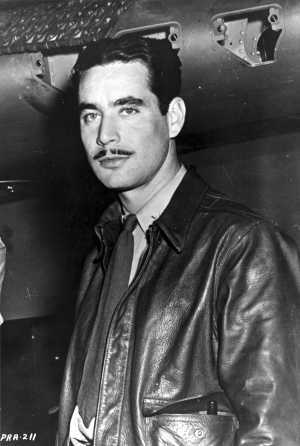
Lt. Boyd “Buzz” Wagner (National Museum of the US Air Force: 050607-F-1234P-025)
80 Years Ago—Dec. 16, 1941: Japanese land in British Borneo.
In the Philippines, P-40 fighter pilot Lt. Boyd Wagner becomes the first US Army Air Force ace (5 victories) in World War II.
The post Today in World War II History—December 16, 1941 first appeared on .December 15, 2021
Today in World War II History—December 15, 1941
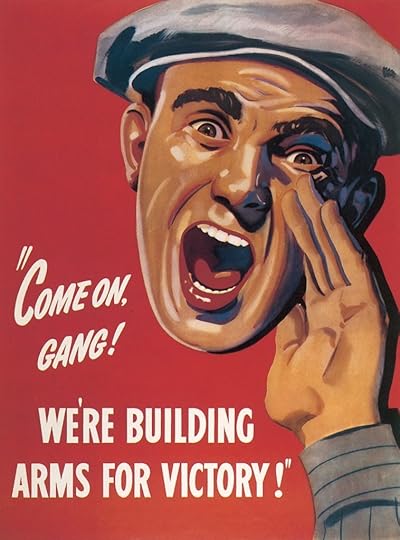
US poster, 1942
80 Years Ago—Dec. 15, 1941: With Germans in retreat, the Soviet government returns to Moscow.
American Federation of Labor adopts a no-strike policy in war industries.
Many US universities agree to cut undergraduate programs to three years by going year-round.
The post Today in World War II History—December 15, 1941 first appeared on .December 14, 2021
Today in World War II History—December 14, 1941
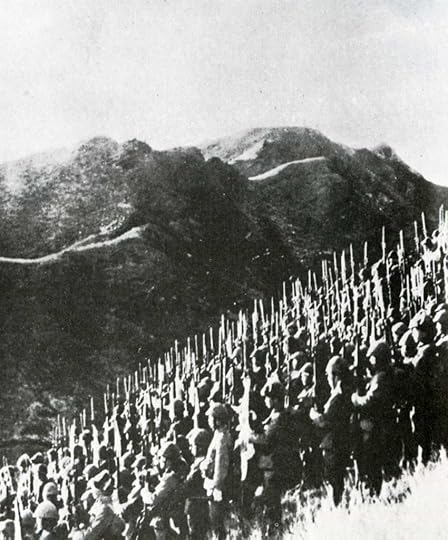
Troops of the Japanese 15th Army preparing to cross into Burma, late Dec 1941 (public domain via WW2 Database)
80 Years Ago—Dec. 14, 1941: Japanese land at Penang, Malaya, and Victoria Point, Burma.
US armed forces extend term of service for enlistments to “duration plus six months.”
The post Today in World War II History—December 14, 1941 first appeared on .December 13, 2021
Today in World War II History—December 13, 1941
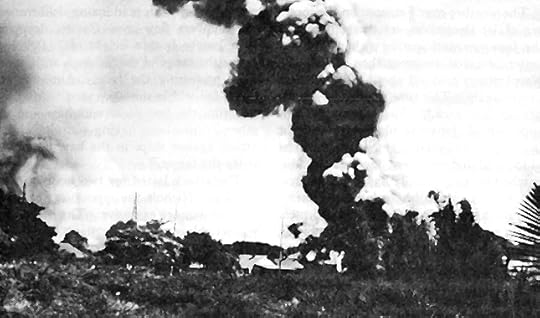
Japanese air attack on Nichols Field on Luzon, 10 December 1941 (US Army Center for Military History)
80 Years Ago—Dec. 13, 1941: Japanese air raid on airfields in the Philippines virtually destroys US air strength.
British attack German General Erwin Rommel’s Gazala line in Libya.
On Niihau, Hawaii, a Japanese pilot downed during the Pearl Harbor attack attempts to seize documents and is killed by islanders.
All Americans in Germany are ordered to report to the US Embassy in Berlin the next day; they will be interned.
New song in the Top Ten: “The White Cliffs of Dover.”
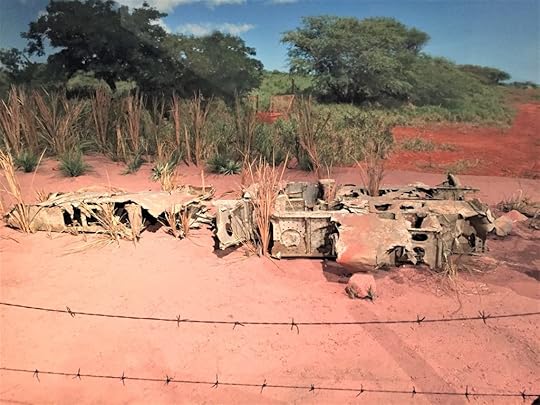
Wreckage of the Japanese Zero that crashed on Niihau during the attack on Pearl Harbor, at the Pearl Harbor Aviation Museum at Pearl Harbor, Hawaii (Photo: Sarah Sundin, 7 Nov 2016)
The post Today in World War II History—December 13, 1941 first appeared on http://www.sarahsundin.com.
December 12, 2021
Today in World War II History—December 12, 1941
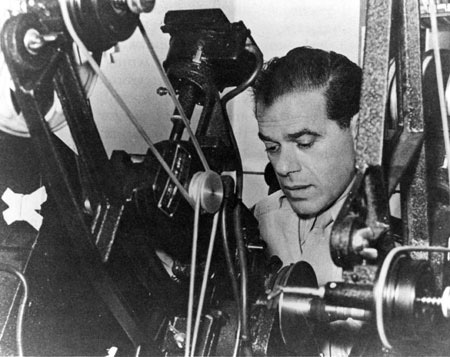
Frank Capra cuts Army film as a Signal Corps Reserve major, 1943 (US Army photo)
80 Years Ago—Dec. 12, 1941: Japanese make small-scale landings at Legaspi, Luzon in the Philippines.
In a rafle (roundup) in Paris, 743 prominent French Jews & 250 foreign Jews are arrested, the first major arrests of French Jews.
Director Frank Capra joins the US Army; he’ll make documentaries with the Special Services Production Unit.
The post Today in World War II History—December 12, 1941 first appeared on http://www.sarahsundin.com.
December 11, 2021
Today in World War II History—December 11, 1941
![Adolf Hitler declaring war on the United States at the German Reichstag, Berlin, 11 Dec 1941 [Photo: German Federal Archive Bild 183-1987-0703-507]](https://i.gr-assets.com/images/S/compressed.photo.goodreads.com/hostedimages/1481539217i/21429626._SX540_.jpg)
Adolf Hitler declaring war on the United States at the German Reichstag, Berlin, 11 Dec 1941 [Photo: German Federal Archive Bild 183-1987-0703-507]
80 Years Ago—Dec. 11, 1941: Germany and Italy declare war on US; US reciprocates.US Marines repulse Japanese landing at Wake in the only successful repulsion of an amphibious landing by shore defenders of the war.
Isolationist “America First” committee is disbanded; the group had tried to keep America out of the war.
John Gillespie Magee Jr., an American serving in the RCAF, is killed in a midair collision over Lincolnshire (age 19) shortly after writing his famous poem “High Flight.”
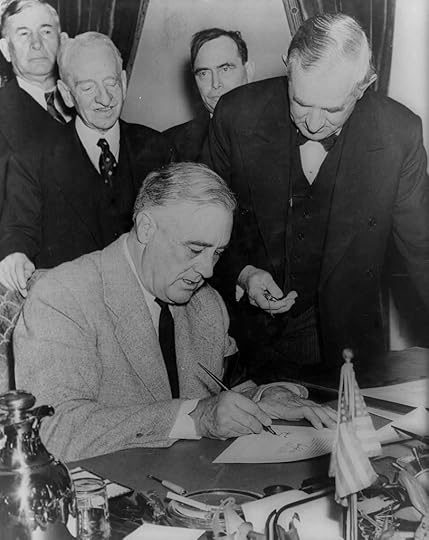
Pres. Franklin Roosevelt signing the declaration of war against Germany, 11 Dec 1941; Senator Tom Connally at right marked the time of declaration (Library of Congress: LC-USZ62-15185)
The post Today in World War II History—December 11, 1941 first appeared on http://www.sarahsundin.com.
December 10, 2021
Today in World War II History—December 10, 1941
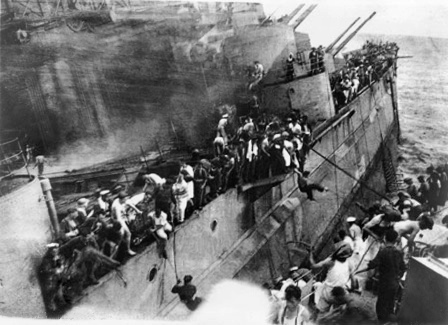
Crew of battleship HMS Prince of Wales abandoning ship, off Malaya, 10 Dec 1941 (Australian War Memorial: P02018.055)
80 Years Ago—Dec. 10, 1941: British enter Tobruk, Libya, relieving 242-day German siege.
First US bombing mission of the war, as B-17s of the 19th Bombardment Group attack Japanese ships off Luzon in the Philippines.
Off Malaya, Japanese G3M bombers sink British battleship HMS Prince of Wales and battlecruiser HMS Repulse—the first time in history that battleships in open sea are sunk by aircraft.
Japanese take Guam, Makin, and Tarawa.
The post Today in World War II History—December 10, 1941 first appeared on http://www.sarahsundin.com.
December 9, 2021
Today in World War II History—December 9, 1941

US poster, WWII
80 Years Ago—Dec. 9, 1941: Soviets retake Tikhvin, Russia, allowing easier supplying of Leningrad.
Japanese invade the Gilbert Islands, landing on Tarawa and Makin.
Japanese occupy Bangkok, Thailand.
New England and New York City have their first air raid alerts; schools and defense plants are evacuated.
The post Today in World War II History—December 9, 1941 first appeared on http://www.sarahsundin.com.
December 8, 2021
Remember Pearl Harbor Tour – From Tragedy to Triumph
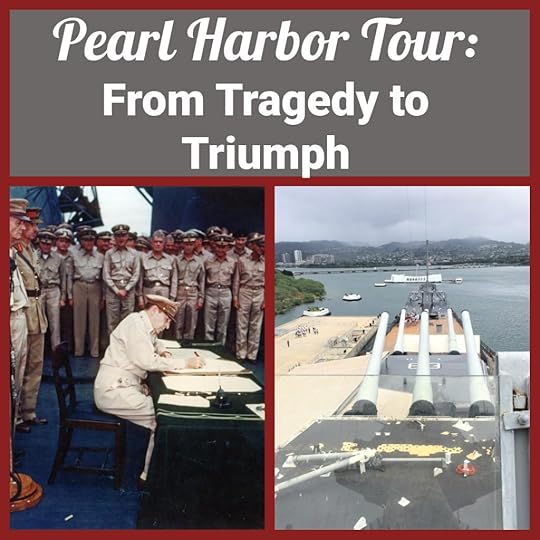
This week marks the 80th anniversary of the attack on Pearl Harbor that launched the United States into World War II. In 2016 I was privileged to visit Pearl Harbor with my husband. This week I’m sharing photographs from our visit, plus some historical background.
I hope these posts help you reflect on the gravity of the attack and the sacrifice of the 2403 servicemen and civilians who died that day. Let’s never forget the lessons of that day.
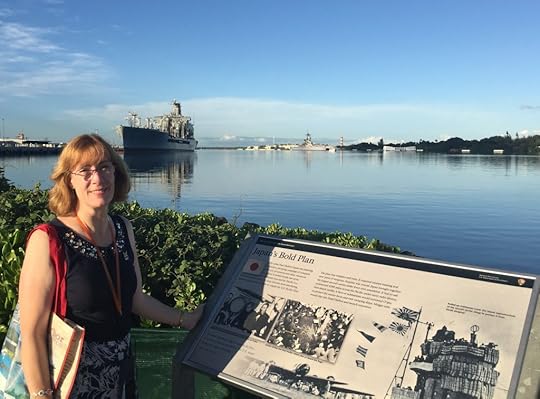
Sarah Sundin at Pearl Harbor, Hawaii, 7 Nov 2016 (Photo: Sarah Sundin)
On Monday I shared about the role of aviation during the attack and showed photos from the Pearl Harbor Aviation Museum. On Tuesday, I shared about the Navy’s role during the attack, along with photos from the USS Arizona Memorial, and today I’ll discuss the road from Pearl Harbor to victory, along with photos from the submarine USS Bowfin and the battleship USS Missouri, where the Japanese signed the surrender documents officially ending World War II on Sept. 2, 1945.
World War II in the PacificWhile the Japanese attack on Pearl Harbor struck a devastating blow and caused a horrific loss of life, that tragic day wasn’t the end of the story. Five great battleships had been sunk, but two were raised and repaired. More importantly, none of America’s aircraft carriers were at Pearl Harbor. As time would tell, the naval battle in the Pacific would be dominated by the carriers, with the battleships slipping into obsolescence. Also, the Japanese called off the third wave of the Pearl Harbor attack, which was meant to demolish the dry docks and oil storage facilities. With those intact, the naval base was able to resume operations quickly.
What the Japanese didn’t bargain on was how the attack would galvanize the American will. After years of bickering about whether or not to get involved in “another European war,” suddenly Americans were unified. Recruiting offices were flooded with young men enlisting, and the government, military, industry, and individual civilians turned with singular determination to winning the war.
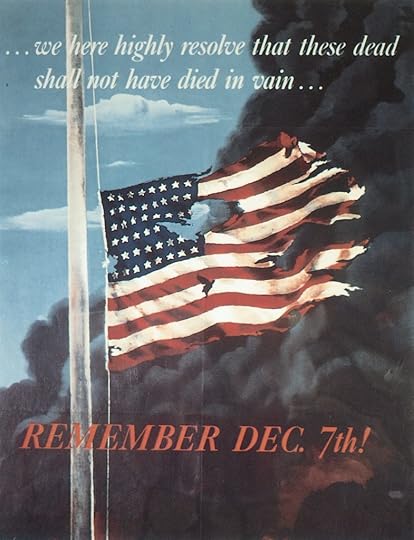
US poster commemorating Pearl Harbor, 1942
The Pearl Harbor Historic Sites tell the story of that horrifying and fateful morning of December 7, 1941 – but they also continue the story, from tragedy to triumph. The Pearl Harbor Aviation Museum tells the role of aviation, from the brave little Cactus Air Force on Guadalcanal to the epic Battle of Midway. And the USS Bowfin and the USS Missouri focus on submarine warfare in the Pacific and on the end of the war.
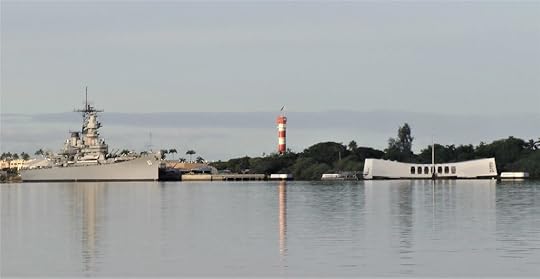
Pearl Harbor Historic Sites: USS Missouri, the control tower at the Pacific Aviation Museum, and the USS Arizona Memorial (Photo: David Sundin, 7 Nov 2016)
Submarine Warfare in the PacificSilent and stealthy, US submarines accounted for half the Japanese ships sunk during the war – 686 warships and 2346 merchant ships. Over the course of the war, 263 US submarines made patrols in the Pacific, and 52 US subs and 3500 submariners were lost. Submarine warfare paralyzed Japanese shipping, reducing shipments of crucial war materials, natural resources, and food to the nation and contributing greatly to Japan’s defeat.
USS BowfinThe submarine USS Bowfin was launched on December 7, 1942, one year after the attack on Pearl Harbor, and so bears the nickname the “Pearl Harbor Avenger.” During World War II, the Bowfin claimed to have sunk 44 Japanese vessels. In the postwar assessment, the claims were reduced – as they were for all subs – to 38 vessels sunk, still an impressive record.
Today the USS Bowfin is a museum ship at Pearl Harbor and well worth a visit, as is the neighboring Pacific Submarine Museum.
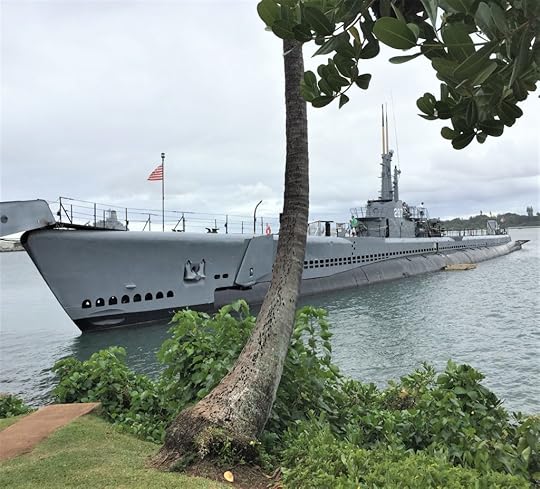
Submarine USS Bowfin, Pearl Harbor (Photo: Sarah Sundin, 7 Nov 2016)
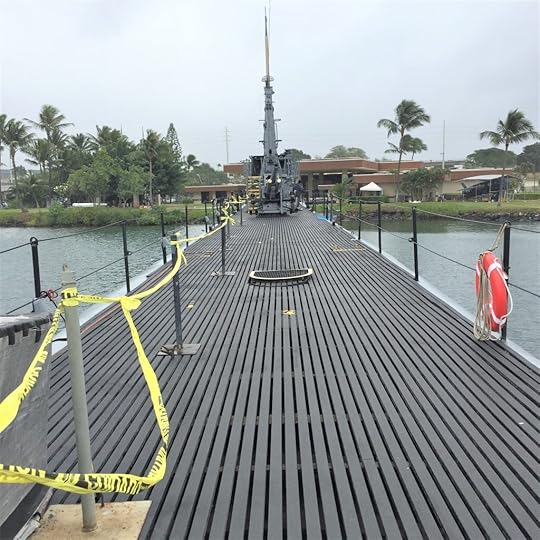
Deck of the submarine USS Bowfin, Pearl Harbor (Photo: Sarah Sundin, 7 Nov 2016)
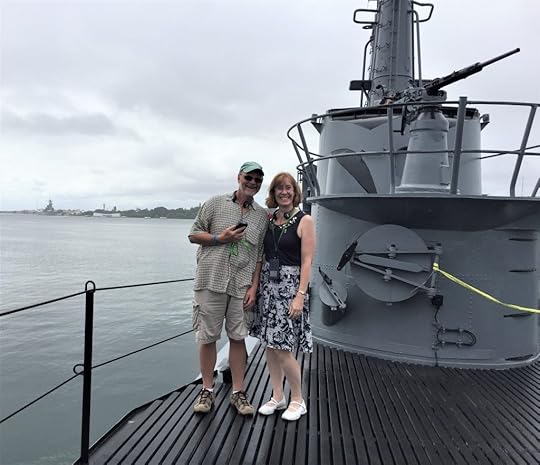
Dave and Sarah Sundin on the submarine USS Bowfin, Pearl Harbor (Photo: Sarah Sundin, 7 Nov 2016)
Below decks, you’re immediately struck by the confined quarters – although not nearly as cramped aboard the German submarine U-505 that we visited recently in Chicago (See my pictures and read about the capture of the U-505 here). No space is wasted on board a submarine. Note the crew berthing stashed between stored torpedoes!
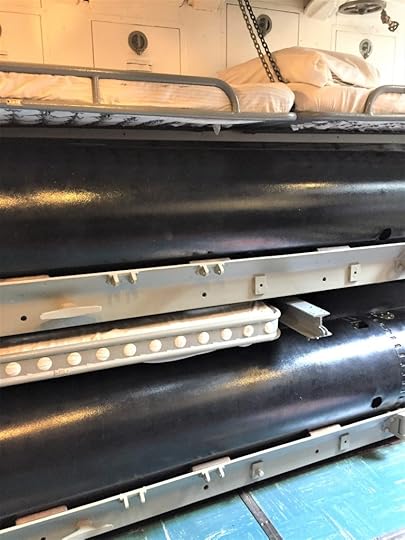
Berths – sandwiched between torpedoes! USS Bowfin, Pearl Harbor (Photo: Sarah Sundin, 7 Nov 2016)
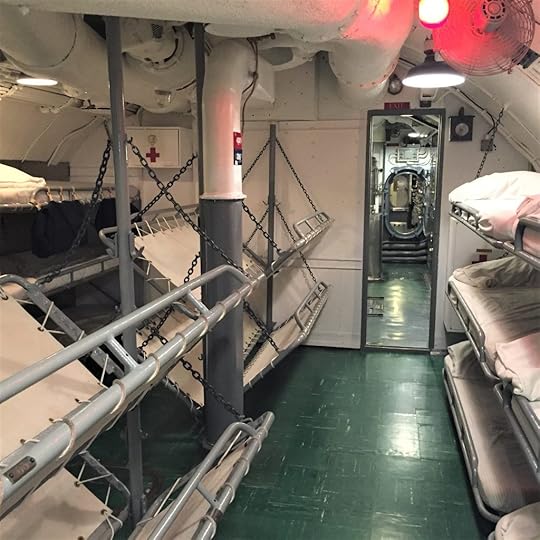
Berths on the USS Bowfin, Pearl Harbor (Photo: Sarah Sundin, 7 Nov 2016)
Submarines performed many roles during World War II – delivering commandos and supplies, rescuing downed airmen, and performing reconnaissance. However, the main role was to sink enemy ships. Torpedoes were the primary weapon used, but the deck guns were also frequently used.
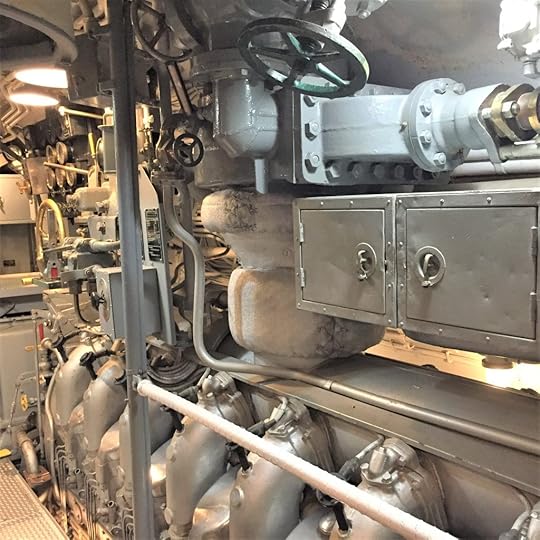
Engines of the USS Bowfin, Pearl Harbor (Photo: Sarah Sundin, 7 Nov 2016)
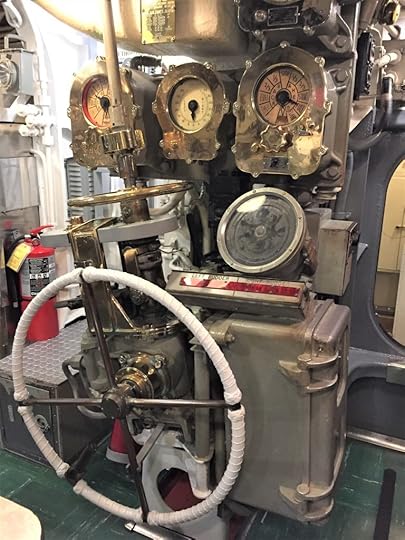
Navigational controls of the USS Bowfin, Pearl Harbor (Photo: Sarah Sundin, 7 Nov 2016)
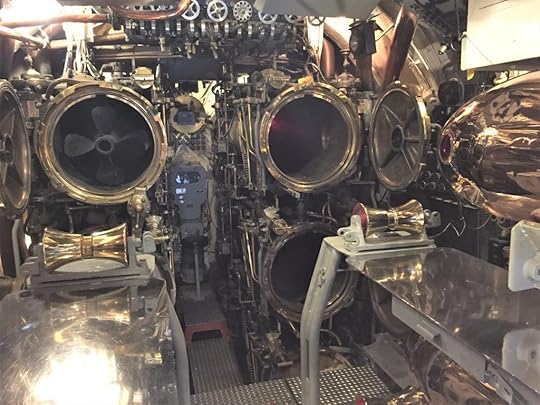
Torpedo tubes on the USS Bowfin, Pearl Harbor (Photo: Sarah Sundin, 7 Nov 2016)
USS Missouri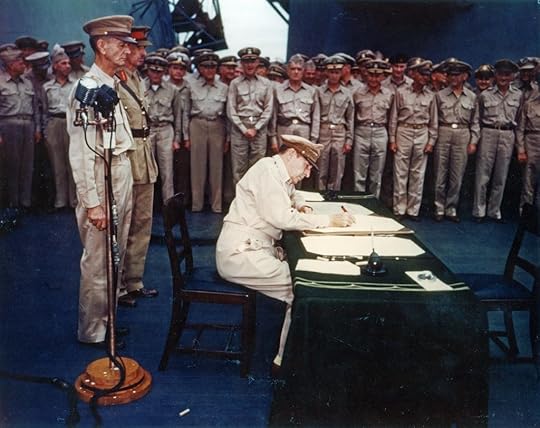
Gen. Douglas MacArthur signing the Japanese surrender documents aboard USS Missouri, 2 Sept 1945 (US National Archives: USA C-4627)
The “Mighty Mo” was commissioned in June 1944 and served in the Pacific, participating in the bombardment of Iwo Jima, Okinawa, and the Japanese home islands. But she’s most famous for serving as the site of the surrender of Japan which officially ended World War II on September 2, 1945. Admiral Chester Nimitz and General Douglas MacArthur headed the US delegation, and high-ranking military men from Britain, China, Australia, New Zealand, Canada, France, the Netherlands, and the USSR were present to receive the Japanese surrender. Almost four years after the attack on Pearl Harbor, the war in the Pacific finally came to an end.
Today the USS Missouri is a beautiful museum ship at Pearl Harbor, her guns angled as if guarding the USS Arizona Memorial.
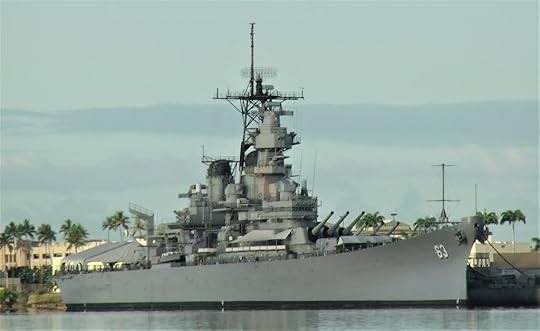
Battleship USS Missouri, Pearl Harbor, Hawaii (Photo: Dave Sundin, 7 Nov 2016)
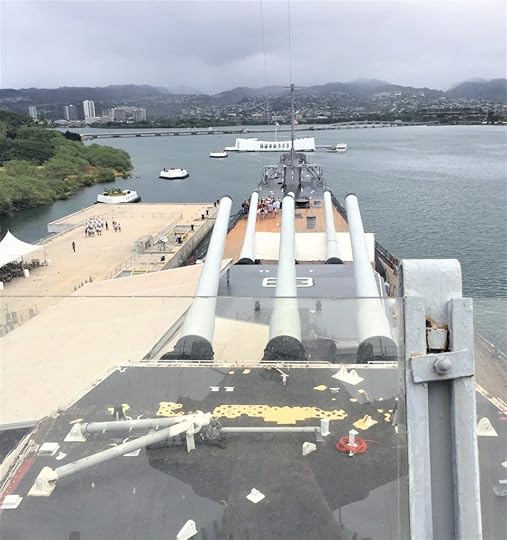
Guns of the battleship USS Missouri keeping watch over the USS Arizona Memorial, Pearl Harbor, Hawaii (Photo: Sarah Sundin, 7 Nov 2016)
Both guided and self-guided tours are available for the USS Missouri. The approach to the ship is marked by flags and a statue of Admiral Chester Nimitz. A statue of the “Kissing Sailor” is a nice touch – a reminder of the joy in America on V-J Day when the war was over.
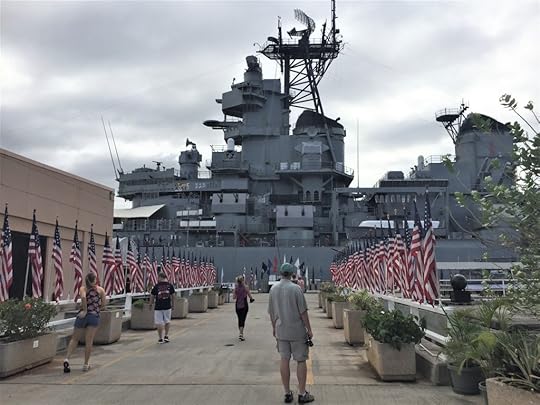
Battleship USS Missouri, Pearl Harbor, Hawaii (Photo: Sarah Sundin, 7 Nov 2016)
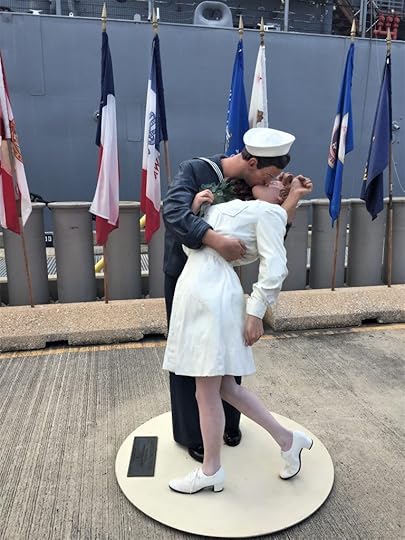
Statue of “The Kiss” at the battleship USS Missouri, Pearl Harbor, Hawaii (Photo: Sarah Sundin, 7 Nov 2016)
The main deck is dominated by the battleship’s massive 16-inch gun batteries. You can also explore the superstructure and below decks.
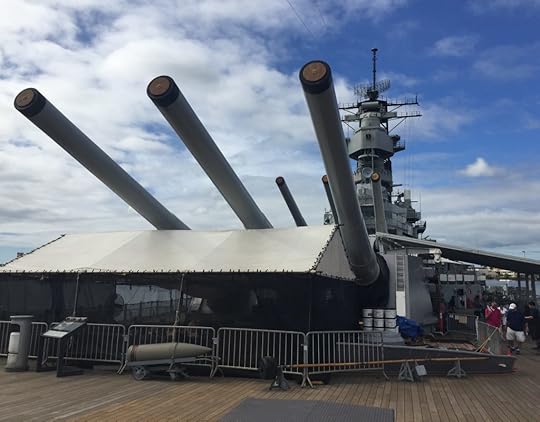
Forward main battery of the battleship USS Missouri, Pearl Harbor, Hawaii (Photo: Sarah Sundin, 7 Nov 2016)
The highlight of the tour is seeing the exact spot where the surrender documents were signed, as well as replicas of the documents.
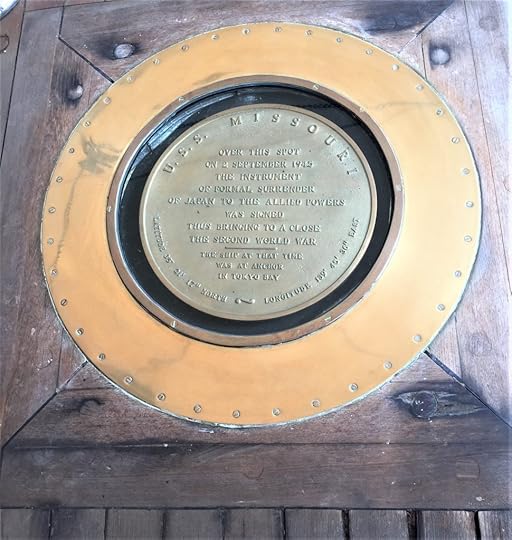
The spot where the Japanese surrender was signed aboard USS Missouri on 2 September 1945. Pearl Harbor, Hawaii (Photo: Sarah Sundin, 7 Nov 2016)
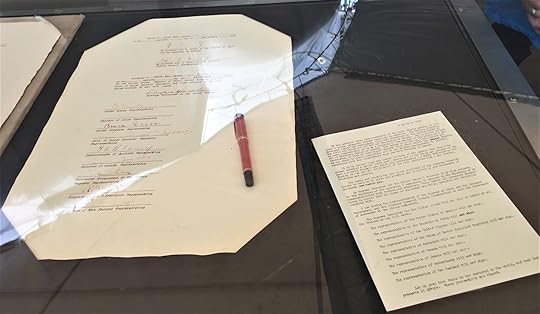
Replicas of the Japanese surrender documents signed aboard USS Missouri on 2 September 1945. Pearl Harbor, Hawaii (Photo: Sarah Sundin, 7 Nov 2016)
Thank you for joining me on my tour! And please visit the other posts:
Day 1: The Role of Aviation During the Attack – Pictures from the Pearl Harbor Aviation Museum
Day 2: The US Navy’s Role at Pearl Harbor – Pictures from the USS Arizona Memorial
The post Remember Pearl Harbor Tour - From Tragedy to Triumph first appeared on http://www.sarahsundin.com.
Today in World War II History—December 8, 1941
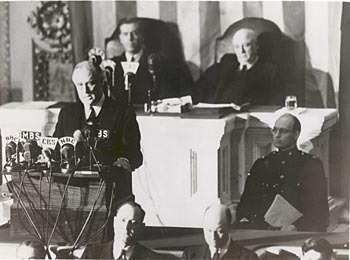
Pres. Franklin Delano Roosevelt delivers his “Day of Infamy” speech to Congress on December 8, 1941. Behind him are Vice President Henry Wallace (left) and Speaker of the House Sam Rayburn. To the right, in uniform in front of Rayburn, is Roosevelt’s son James, who escorted his father to the Capitol (US National Archives)
80 Years Ago—Dec. 8, 1941: President Roosevelt makes “date which will live in infamy” speech to Congress about the Pearl Harbor attack.
US House votes 388-1 and Senate votes 82-0 to declare war on Japan; Roosevelt signs at 5:10 pm.
Japanese attack US airfields in the Philippines, destroying 123 aircraft.
Japanese forces land in Thailand and Malaya.
Air raid alerts occur in San Francisco, and in Seattle, a mob throws rocks at lights to enforce the blackout.
The post Today in World War II History—December 8, 1941 first appeared on http://www.sarahsundin.com.



